Fasces

Fasces (English: /ˈfæsiːz/, Latin: [ˈfa.skeːs]; a plurale tantum, from the Latin word fascis, meaning "bundle";[1] Italian: fascio littorio) is a bound bundle of wooden rods, sometimes including an axe with its blade emerging. The fasces had its origin in the Etruscan civilization and was passed on to ancient Rome, where it symbolized a magistrate's power and jurisdiction. The axe originally associated with the symbol, the Labrys (Greek: λάβρυς, lábrys) the double-bitted axe, originally from Crete, is one of the oldest symbols of Greek civilization. To the Romans, it was known as a bipennis.[2] Commonly, the symbol was associated with female deities, from prehistoric through historic times.
The image has survived in the modern world as a representation of magisterial or collective power, law and governance. The fasces frequently occurs as a charge in heraldry: it is present on the reverse of the U.S. Mercury dime coin and behind the podium in the United States House of Representatives; and it was the origin of the name of the National Fascist Party in Italy (from which the term fascism is derived).
During the first half of the 20th century both the fasces and the swastika (each symbol having its own unique ancient religious and mythological associations) became heavily identified with the authoritarian/fascist political movements of Adolf Hitler and Benito Mussolini. During this period the swastika became deeply stigmatized, but the fasces did not undergo a similar process.
The fact that the fasces remained in use in many societies after World War II may have been due to the fact that prior to Mussolini the fasces had already been adopted and incorporated within the governmental iconography of many governments outside Italy. As such, its use persists as an accepted form of governmental and other iconography in various contexts. (The swastika remains in common usage in parts of Asia for religious purposes which are also unrelated to early 20th century European fascism.)
The fasces is sometimes confused with the related term fess, which in French heraldry is called a fasce.
Origin and symbolism
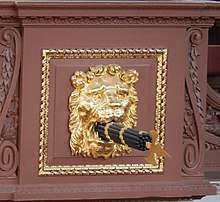
Little is known about the Etruscans, but a few artifacts have been found showing a thin bundle of rods surrounding a two-headed axe.[3] Fasces symbolism might be derived via the Etruscans from the eastern Mediterranean, with the labrys, the Anatolian, and Minoan double-headed axe, later incorporated into the praetorial fasces. There is little archaeological evidence.[4]
By the time of the Roman Republic, the fasces had developed into a thicker bundle of birch rods, sometimes surrounding a single-headed axe and tied together with a red leather ribbon into a cylinder. On certain special occasions, the fasces might be decorated with a laurel wreath.
The symbolism of the fasces suggested strength through unity (see Unity makes strength); a single rod is easily broken, while the bundle is very difficult to break. This symbolism occurs in Aesop's fable "The Old Man and his Sons". A similar story is told about the Bulgar (pre-Bulgarian, proto-Bulgarian) Khan Kubrat, giving rise to the Bulgarian national motto "Union gives strength" (Съединението прави силата). "It is often claimed that the rods could be used to lash people, and the ax to execute them. This may have been true in the days of the monarchy, but not during the republic."[5] where no Roman magistrate could summarily execute a Roman citizen after passage of the laws of the twelve tables.[6] Bundled birch twigs symbolise corporal punishment (see birching).
Republican Rome
The fasces lictoriae ("bundles of the lictors") symbolised power and authority (imperium) in ancient Rome, beginning with the early Roman Kingdom and continuing through the republican and imperial periods. By republican times, use of the fasces was surrounded with tradition and protocol. A corps of apparitores (subordinate officials) called lictors each carried fasces before a magistrate, in a number corresponding to his rank. Lictors preceded consuls (and proconsuls), praetors (and propraetors), dictators, curule aediles, quaestors, and the Flamen Dialis during Roman triumphs (public celebrations held in Rome after a military conquest).
According to Livy, it is likely that the lictors were an Etruscan tradition, adopted by Rome.[7] The highest magistrate, the dictator, was entitled to twenty-four lictors and fasces, the consul to twelve, the proconsul eleven, the praetor six (two within the pomerium), the propraetor five, and the curule aediles two.
Another part of the symbolism developed in Republican Rome was the inclusion of just a single-headed axe in the fasces, with the blade projecting from the bundle. The axe indicated that the magistrate's judicial powers (imperium) included capital punishment. Fasces carried within the Pomerium—the boundary of the sacred inner city of Rome—had their axe blades removed; within the city, the power of life and death rested with the people through their assemblies. During times of emergency, however, the Roman Republic might choose a dictator to lead for a limited time period, who was the only magistrate to be granted capital punishment authority within the Pomerium. Lictors attending the dictator kept the axes in their fasces even inside the Pomerium—a sign that the dictator had the ultimate power in his own hands. There were exceptions to this rule: in 48 BC, guards holding bladed fasces guided Vatia Isauricus to the tribunal of Marcus Caelius, and Vatia Isauricus used one to destroy Caelius's magisterial chair (sella curulis).
An occasional variation on the fasces was the addition of a laurel wreath, symbolizing victory. This occurred during the celebration of a Triumph - essentially a victory parade through Rome by a returning victorious general. Previously, all Republican Roman commanding generals had held high office with imperium, and so, already were entitled to the lictors and fasces.
Usage
The modern Italian word fascio, used in the twentieth century to designate peasant cooperatives and industrial workers' unions, is related to fasces.
Numerous governments and other authorities have used the image of the fasces as a symbol of power since the end of the Roman Empire. It also has been used to hearken back to the Roman republic, particularly by those who see themselves as modern-day successors to the old republic or its ideals.
The Ecuadorian coat of arms incorporated the fasces in 1830, although it had already been in use in the coat of arm of Gran Colombia since 1821.
Italian Fascism, which derives its name from the fasces, arguably used this symbolism the most in the twentieth century. The British Union of Fascists also used it in the 1930s. The fasces, as a widespread and long-established symbol in the West, however, has avoided the stigma associated with much of fascist symbolism, and many authorities continue to display them, including the federal government of the United States.
France
A review of the images included in Les Grands Palais de France Fontainebleau [8][9] reveals that French architects used the Roman fasces (faisceaux romains) as a decorative device as early as the reign of Louis XIII (1610–1643) and continued to employ it through the periods of Napoleon I's Empire (1804–1815).
The fasces typically appeared in a context reminiscent of the Roman Republic and of the Roman Empire. The French Revolution used many references to the ancient Roman Republic in its imagery. During the First Republic, topped by the Phrygian cap, the fasces is a tribute to the Roman Republic and means that power belongs to the people. It also symbolizes the "unity and indivisibility of the Republic",[10] as stated in the French Constitution. In 1848 and after 1870, it appears on the seal of the French Republic, held by the goddess, Liberty. There is the fasces in the arms of the French Republic with the "RF" for République française (see image below), surrounded by leaves of olive tree (as a symbol of peace) and oak (as a symbol of justice). While it is used widely by French officials, this symbol never was officially adopted by the government.[10]
The fasces appears on the helmet and the buckle insignia of the French Army's Autonomous Corps of Military Justice, as well as on that service's distinct cap badges for the prosecuting and defending lawyers in a court-martial.
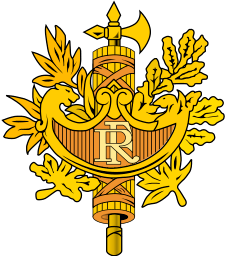 The unofficial but common National Emblem of France is backed by a fasces, representing justice
The unofficial but common National Emblem of France is backed by a fasces, representing justice Les Grands Palais de France Fontainebleau
Les Grands Palais de France Fontainebleau
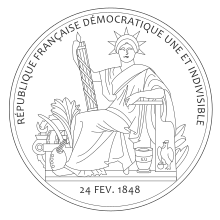 Great Seal of France, 1848
Great Seal of France, 1848
United States
.svg.png)
Since the original founding of the United States in the 18th century, several offices and institutions in the United States have heavily incorporated representations of the fasces into much of their iconography.
Federal fasces iconography
- The reverse of the Mercury Dime, the design used until the adoption of the current FDR dime in 1945, features a fasces.
- In the Oval Office, above the door leading to the exterior walkway, and above the corresponding door on the opposite wall, which leads to the president's private office; note: the fasces depicted have no axes, possibly because in the Roman Republic, the blade was always removed from the bundle whenever the fasces were carried inside the city, in order to symbolize the rights of citizens against arbitrary state power (see above)
- Two fasces appear on either side of the flag of the United States behind the podium in the United States House of Representatives, and were added to the chamber's decor during the remodeling project of 1950.[11]
- The Mace of the United States House of Representatives resembles fasces and consists of thirteen ebony rods bound together in the same fashion as the fasces, topped by a silver eagle on a globe
- The official seal of the United States Senate has as one component a pair of crossed fasces
- Fasces ring the base of the Statue of Freedom atop the United States Capitol building
- A frieze on the facade of the United States Supreme Court building depicts the figure of a Roman centurion holding a fasces, to represent "order"[12]
- The National Guard uses the fasces on the seal of the National Guard Bureau, and it appears in the insignia of Regular Army officers assigned to National Guard liaison and in the insignia and unit symbols of National Guard units themselves; for instance, the regimental crest of the 71st Infantry Regiment (New York) of the New York National Guard consisted of a gold fasces set on a blue background
- At the Lincoln Memorial, Lincoln's seat of state bears the fasces—without axes—on the fronts of its arms; fasces also appear on the pylons flanking the main staircase leading into the memorial
- The official seal of the United States Tax Court bears the fasces at its center
- Four fasces flank the two bronze plaques on either side of the bust of Lincoln memorializing his Gettysburg Address at Gettysburg, Pennsylvania
- The seal of the United States Courts Administrative Office includes a fasces behind crossed quill and scroll
- In the Washington Monument, there is a statue of George Washington leaning on a fasces
- A fasces is a common element in U.S. Army Military Police heraldry, most visibly on the shoulder sleeve insignia of the 18th Military Police Brigade and the 42nd Military Police Brigade
- A fasces also appears shoulder sleeve insignia of the U.S. Army Reserve Legal Command
- Seated beside George Washington, a figure holds a fasces as part of The Apotheosis of Washington, a fresco mural suspended above the rotunda of the United States Capitol Building.
State, local and other fasces iconography
- The main entrance hallways in the Wisconsin State Capitol have lamps that are decorated with stone fasces motifs; in the woodwork before the podium of the speaker of the assembly, several double-bladed fasces are carved, but in the woodwork before the podium of the senate president are several single-bladed fasces
- The grand seal of Harvard University inside Memorial Church is flanked by two inward-pointing fasces; the seal is located directly below the 112 m (368 ft) steeple and the Great Seal of the United States inside the Memorial Room; the walls of the room list the names of Harvard students, faculty, and alumni who gave their lives in service of the United States during World War I along with an empty tomb depicting Alma Mater holding a slain Harvard student
- The fasces appears on the state seal of Colorado, U.S., beneath the "All-seeing eye" (or Eye of Providence) and above the mountains and mines
- The hallmark of the Kerr & Co silver company was a fasces
- On the seal of the New York City borough of Brooklyn, a figure carries a fasces; the seal appears on the borough flag; fasces also can be seen in the stone columns at Grand Army Plaza and on a flagpole in Washington Square Park
- the symbol is used as part of the Knights of Columbus emblem (designed in 1883)
- Many local police departments use the fasces as part of their badges and other symbols, for instance, the top border of the Los Angeles Police Department badge features a fasces (1940)
- Commercially, a small fasces appeared at the top of one of the insignia of the Hupmobile automobile
- A fasces appears on the statue of George Washington, made by Jean-Antoine Houdon that is now in the Virginia State Capital; fasces are used as posts of the 1818 cast-iron fence surrounding the capitol building
- Columns in the form of fasces line the entrance to Buffalo City Hall
- VAW-116 have a fasces on their unit insignia
- San Francisco's Coit Tower has two fasces-like insignia (without the axe) carved above its entrance, flanking a Phoenix
- Two monuments erected in Chicago at the time of the Century of Progress Exposition are adorned with fasces; the monument to Christopher Columbus (1933) in Grant Park has them on the ends of its exedra; the Balbo Monument in Burnham Park, (1934) a gift from Benito Mussolini, has the vandalized remains of fasces on all four corners of its plinth[13]
Examples of US fasces iconography
 Most visibly, fasces bestride the U.S. flag in the House chamber of the US Capitol
Most visibly, fasces bestride the U.S. flag in the House chamber of the US Capitol Above the door leading out of the Oval Office
Above the door leading out of the Oval Office Mercury dime reverse
Mercury dime reverse
 The mace of the United States House of Representatives, designed to resemble fasces
The mace of the United States House of Representatives, designed to resemble fasces The seal of the Senate, note the crossed fasces at the bottom
The seal of the Senate, note the crossed fasces at the bottom The seal of the United States Tax Court
The seal of the United States Tax Court The Lincoln Memorial with the fronts of the chair arms shaped to resemble fasces
The Lincoln Memorial with the fronts of the chair arms shaped to resemble fasces- Flanking the image of Lincoln at the Gettysburg Address memorial
 The seal of the Administrative Office of the United States Courts
The seal of the Administrative Office of the United States Courts Above the door to Chicago's City Hall
Above the door to Chicago's City Hall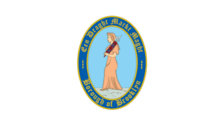 The flag of the New York City borough of Brooklyn
The flag of the New York City borough of Brooklyn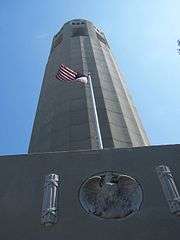 At the entrance to San Francisco's Coit Tower
At the entrance to San Francisco's Coit Tower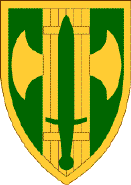 Shoulder Sleeve Insignia of the 18th MP Brigade
Shoulder Sleeve Insignia of the 18th MP Brigade.png) Shoulder Sleeve Insignia of the 42nd MP Brigade
Shoulder Sleeve Insignia of the 42nd MP Brigade- Statue of George Washington at the site of his inauguration as first president of the United States, now occupied by Federal Hall National Memorial, includes a fasces to the subject's rear right
 Horatio Stone's 1848 statue of Alexander Hamilton displays a fasces below Hamilton's hand
Horatio Stone's 1848 statue of Alexander Hamilton displays a fasces below Hamilton's hand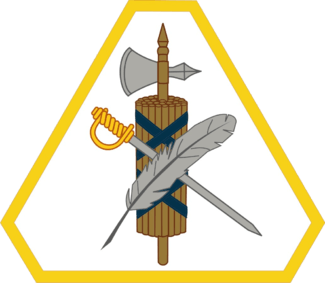 Shoulder Sleeve Insignia of U.S. Army Reserve Legal Command
Shoulder Sleeve Insignia of U.S. Army Reserve Legal Command Portion of The Apotheosis of Washington, a fresco mural suspended above the rotunda of the United States Capitol Building.
Portion of The Apotheosis of Washington, a fresco mural suspended above the rotunda of the United States Capitol Building.
Modern authorities and movements
- Benito Mussolini's tomb is flanked by marble fasces
The following cases all involve the adoption of the fasces as a symbol or icon, although no physical re-introduction has occurred.
- Aiguillettes worn by aides-de-camp in many Commonwealth armed forces bear the fasces on the metal points; the origin of this is unknown, as the fasces is an uncommon symbol in British and Commonwealth heraldry and insignia
- The Miners Flag (also known as the "Diggers' Banner"), the standard of nineteenth-century gold-miners in the colony of Victoria, in Australia, included the fasces as a symbol of unity and strength of common purpose; this flag symbolized the movement prior to the rebellion at the Eureka Stockade (1854)
- The British Union of Fascists originally used the fasces on their flag until adopting the Flash and Circle
- The coat of arms of Ecuador, which also is featured on its national flag, has included a fasces since 1822
- The coat of arms of Cameroon features two fasces that form a diagonal cross
- The coat of arms of Cuba features a fasces
- The third flag of Gran Colombia, a former nation in South America, depicted a large fasces entwined with several arrows
- The coat of arms of Norte de Santander, a department of Colombia, and of its capital Cúcuta, both feature a fasces
- The coat of arms of the Romanian Police features two crossed fasces
- The Grand Coat of Arms of Vilnius, Lithuania features a fasces
- The crests of many collegiate fraternities and sororities feature the fasces, including those of Chi Phi, Alpha Phi Delta, Sigma Alpha Mu, and Psi Upsilon
- The symbol of the National Party (Uruguay) (Partido Nacional) includes a fasces
- On the entrance of the Royal Castle of Laeken in Belgium
- The emblem of the Spanish gendarmerie Guardia Civil includes a fasces
- Both the Norwegian and Swedish police have double fasces in their coats of arms
- The emblem of the Russian Federal Penitentiary Service includes a fasces in one of the double-headed eagle's feet
 The coat of arms of the Swiss canton of St. Gallen has displayed the fasces since 1803
The coat of arms of the Swiss canton of St. Gallen has displayed the fasces since 1803.svg.png) Flag of the National Fascist Party of Italy (1915 - 1945). Fascism used the fasces as its political symbol.
Flag of the National Fascist Party of Italy (1915 - 1945). Fascism used the fasces as its political symbol..svg.png) Greater coat of arms of Italy of 1929-1943, during the Fascist era, bearing the fasces
Greater coat of arms of Italy of 1929-1943, during the Fascist era, bearing the fasces- Fragment of the facade of the building of the Silesian Parliament in Katowice
.svg.png) The original flag of the British Union of Fascists
The original flag of the British Union of Fascists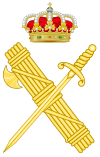 Guardia Civil (Spain)
Guardia Civil (Spain) The Grand Coat of Arms of Vilnius, Lithuania bearing the fasces
The Grand Coat of Arms of Vilnius, Lithuania bearing the fasces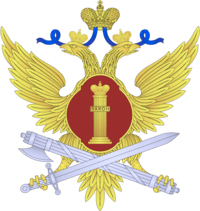 The emblem of the Russian Federal Penitentiary Service, bearing the fasces
The emblem of the Russian Federal Penitentiary Service, bearing the fasces
See also
- Faggot (bundle of sticks)
- Fascine (bundle of wood or other material used in earthworks)
- Fascio (usage 1890s to World War I)
- Fascism
- Ferula
- Francisca
- Labrys
- Staff of office
- Yoke and arrows
References
- ↑ Merriam-Webster Online Dictionary: fasces
- ↑ the term for a single-bladed axe being hēmipelekys "half-pelekys", e.g. Il. 23.883.
- ↑ Haynes, S. (2000). Etruscan civilization: A cultural history. Los Angeles: J. Paul Getty Museum.
- ↑ "Fasces". 2011-03-26. Retrieved 2011-04-13.
- ↑ "Fasces - Livius". www.livius.org.
- ↑ Livius.org, fasces
- ↑ Livy, Ab urbe condita, 1:8
- ↑ Les Grands Palais de France Fontainebleau, I re Série, Styles Louis XV, Louis XVI, Empire, Labrairie Centrale D'Art Et D'Architecture, Ancienne Maison Morel, Ch. Eggimann, Succ, 106, Boulevard Saint Germain, Paris, 1910
- ↑ Les Grands Palais de France : Fontainebleau , II me Série, Les Appartments D'Anne D'Autriche, De François I er, Et D'Elenonre La Chapelle, Labrairie Centrale D'Art Et D'Architecture, Ancienne Maison Morel, Ch. Eggimann, Succ, 106, Boulevard Saint Germain, Paris, 1912
- 1 2 Site of the French Presidency Archived November 4, 2012, at the Wayback Machine.
- ↑ US House of Representatives: Chamber, 1951–Present history.house.gov website. Downloaded Aug. 17, 2017.
- ↑ The Supreme Court Historical Society Archived November 28, 2005, at the Wayback Machine.
- ↑ Bach, Ira and Mary Lackritz Gray, ‘’A Guide to Chicago’s Public Sculpture, The University of Chicago Press, Chicago, 1983 p. 11-12
Sources
- Tassi Scandone Elena, Verghe, scuri e fasci littori in Etruria - Contributo allo studio degli insignia imperii. Volume n. 36 della Biblioteca di Studi Etruschi dell'Istituto Nazionale di Studi Etruschi ed Italici, Istituti Editoriali e Poligrafici Internazionali, Pisa - Roma, 2001. ISBN 88-8147-263-5. Pp. 272, con VII tavv. f.t.
- Salvatori Paola S., L’adozione del fascio littorio nella monetazione dell’Italia fascista, in «Rivista italiana di numismatica e scienze affini», CIX, 2008, pp. 333–352.
External links
| Wikimedia Commons has media related to Fasces. |
| Wikisource has the text of the 1911 Encyclopædia Britannica article Fasces. |
- Fasces - Ancient History Encyclopedia
- A definition
- Livius.org: Fasces
- Fasces on flags
- The fasces as Ancient Roman icon
- Reverse of 1989 Congress Bicentennial Silver Dollar showing fasces